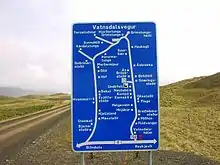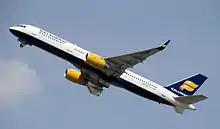Transport in Iceland
The modes of transport in Iceland are governed by the country's rugged terrain and sparse population. The principal mode of personal transport is the car. There are no public railways, although there are bus services. Transport from one major town to another, for example Reykjavík to Akureyri, may be by aeroplane on a domestic flight. The only ways of getting in and out of the country are by air and sea. Most of the country's transport infrastructure is concentrated near the Capital Region, which is home to two thirds of the country's population.

Rail
Iceland has no public railways, although proposals to build a passenger line between Keflavík and Reykjavík have been made as well as proposals to build a light rail system in Reykjavík.[1]
In the past, locomotive-powered and hand-operated rails have been temporarily set up during certain construction projects, and have long since been dismantled. Some artifacts from their existence remains in museums and as static exhibits.
Road

.png.webp)
Iceland has 12,869 kilometres (7,996 mi) of publicly administered roads, 5,040 kilometres (3,130 mi) of which are paved.[2] Organized road building began about 1900 and has greatly expanded since 1980. Vegagerðin (Icelandic Roads Administration) is the legal owner and constructor of the roads, and oversees and maintains them as well. 11.4% of passenger-kilometres are by bus and 88.6% by car.[3]
Sea
The major harbours in Iceland are:
- Akureyri
- Hornafjördur
- Ísafjörður
- Keflavík
- Raufarhöfn
- Reykjavík
- Seyðisfjörður
- Straumsvík
- Vestmannaeyjar
Merchant marine:
total:
3 ships (with a tonnage of 1,000gt or over) totaling 13,085gt/16,938 tonnes deadweight (DWT)
ships by type:
chemical tanker 1, container ship 1, petroleum tanker 1 (1999 est.)
Transport ferries: The only habitable islands around Iceland are supplied and infrastructurally connected with the mainland via ferries which run regularly. Those islands are:
- Vestmannaeyjar The largest and most populated island.
- Hrísey In the middle of Eyjafjörður in northern Iceland.
- Grímsey An island in the far-north, the northernmost part of Iceland.
Those ferries are considered part of the infrastructure system such as roads, and are therefore run by Vegagerðin like the roads.
Air

As of 2010,[4] there are 98 airports in Iceland:
| Length | Paved | Unpaved | Totals |
|---|---|---|---|
| over 3,047 m | 1 | 0 | 1 |
| 1,524 to 2,437 m | 3 | 3 | 6 |
| 914 to 1,523 m | 2 | 27 | 29 |
| under 914 m | 0 | 63 | 63 |
| Total | 6 | 93 | 99 |
Public transport
Strætó bs is a company which operates bus services in The Capital Region and Strætisvagnar Akureyrar operates bus services in Akureyri.
References
- "MPs Propose Trains in Iceland". Iceland Review. 2008-02-20. Retrieved 2010-04-25.
- "Samgönguáætlun 2009-2012 (National transport plan 2009-2012)" (PDF). Alþingi (Icelandic parliament). Retrieved 2010-04-25.
- "Eurostat - Modal split of passenger transport". ec.europa.eu. Retrieved 2018-04-20.
- "CIA World Factbook". CIA World Factbook. CIA.
